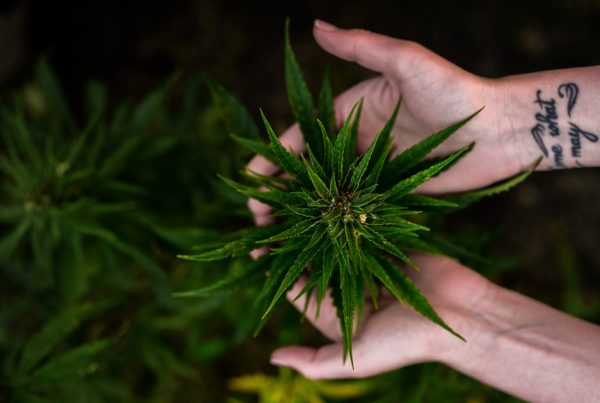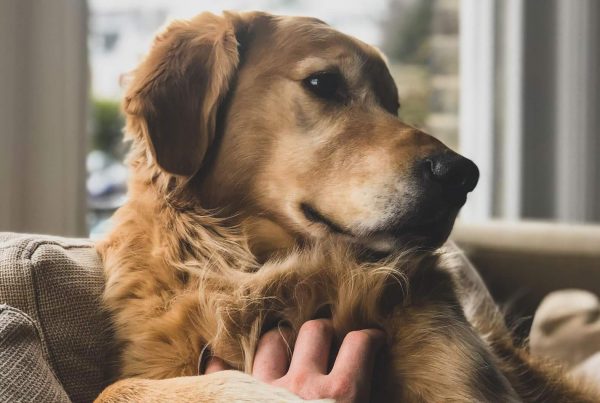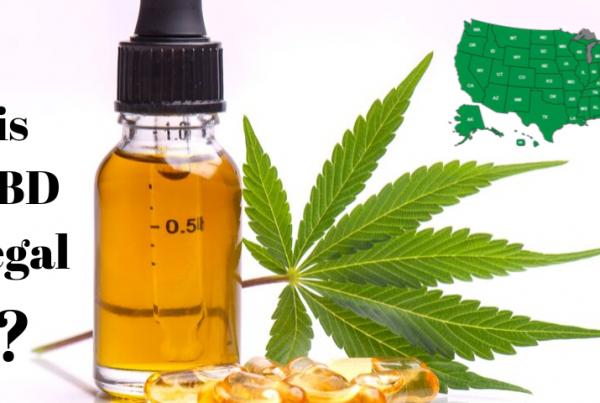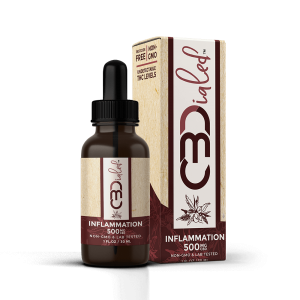
Our complete guide to CBD for pets will help you understand the endocannabinoid system, how it works with major systems in the body and how CBD may support healthy functions in your pet’s body. We’ll also help you understand what the proper doses of CBD for your pets are and when/how to increase doses. Many pet parents are taking a natural approach when it comes to improving some symptoms in their pets.
In California, for example, vets can actually speak with pet parents about CBD for pets, but cannot prescribe, administer or endorse a specific CBD product. It’s always a good idea to talk to your vet before starting your pet on CBD.
What is CBD?
Cannabidiol (CBD) is found in both hemp and cannabis plants. It is non-intoxicating, meaning that it does not induce a “high”. CBD is the most abundant cannabinoid in hemp and the 2nd most abundant cannabinoid in cannabis.
CBDialed’s Pet CBD products all use CBD oil that is derived from organically grown hemp.
The Different Types of CBD Oil
There are three types of CBD oil: full spectrum, broad spectrum and CBD isolate.
When raw CBD oil is extracted from the hemp plant, it contains all of the natural components of the plant. The raw oil is put through several refinement and distillation processes to achieve one of these three types of CBD oil.
Full spectrum CBD oil contains all of the cannabinoids and terpenes that are naturally found in the hemp plant. The THC content (0.3% or less) is also maintained. The only thing stripped here is unwanted plant material, heavy metals and chlorophyll.
Broad spectrum CBD oil starts as either full spectrum oil or CBD isolate. Most or all of the THC is removed. Some products, such as the pet products offered by CBDialed contain THC in a concentration that is less than what labs test for. Labs test for THC of 0.3%, anything less is undetectable. Broad spectrum CBD oil that does contain a miniscule amount of THC contains 0.1% or less, on average. Products in this category that begin with CBD isolate are unable to achieve the entourage effect.
The entourage effect refers to all of the cannabinoids and terpenes naturally found in the original source staying in the extracted oil to work together creating synergy.
CBD isolate strips everything from the raw CBD extract except the CBD. It is not possible to achieve the entourage effect since THC and any other naturally-occurring cannabinoid is missing. CBD isolate is considered to be inferior to broad spectrum and full spectrum.
What can I ask my Vet?
When it comes to CBD for pets, it depends on where you live as to what you can ask your vet. In California, the Compassionate Care Law for Pets is in place. This law allows a vet to speak with a pet owner about using CBD oil for their animals. Your vet cannot, however, administer or prescribe CBD oil. The vet also cannot make specific suggestions regarding a specific brand of CBD oil.
Your vet can discuss what CBD oil is and if it would benefit your pet.
In other areas of the country, it depends on your vet. Some will discuss CBD oil with you, others may not. There are some vets in the country that do recommend taking an all-natural approach with your pet’s health by specifically suggesting CBD for pets.
If your vet is open to speaking about CBD, ask these questions:
- What type of CBD for pets product should I use?
- How should I administer it to my pet?
- Will CBD interact with any of my pet’s medications?
- How often should I give my pet CBD?
The thing about CBD for pets is that it is rather new. Pets do have an endocannabinoid system, as all mammals do, but not many vets have educated themselves on CBD.
The Pet Endocannabinoid System
All mammals have an endocannabinoid system. This system works in conjunction with the central and peripheral nervous systems. These systems help regulate most of the functions of the body. The endocannabinoid system is what helps your pet’s body maintain homeostasis (balance).
When a function or reaction in the body is not in balance, an improper response may be triggered. Adjustments are automatically made by the body to put these functions back to normal functioning status. If a cannabinoid deficiency is present, the response to “auto-fix” may not be made. The body produces endocannabinoids naturally.
The functions affected by the endocannabinoid system include:
- Appetite
- Coordination
- Immune response
- Inflammatory response
- Memory
- Metabolism
- Mood
- Movement
- Pleasure
- Sleep
When your pet’s endocannabinoid system is in proper working order and their bodies are balanced correctly, this helps maximize your pet’s overall health and wellness. When speaking with your vet about CBD for pets, find out which part of their endocannabinoid system may be off-balance.
How the Endocannabinoid System Operates
The endocannabinoid system works with cannabinoid receptors. CB1 receptors are found in the central nervous system which includes the spinal cord and brain. CB2 receptors are located in the immune system and major organs. When these receptors are activated, their job is to send appropriate messages to various nerve cells so that balance (homeostasis) can be restored to that specific function.
Introducing your Pet to CBD Oil
Your pet’s body is already designed to work with CBD oil due to the endocannabinoid system, so CBD is safe to give your pet. When you want to start administering CBD for pets, it’s a good idea to learn a little bit about CBD first. While your vet can’t exactly prescribe CBD for pets, you can follow a few simple guidelines.
For pets, there are three tiers of suggested doses.
Tier 1: A small dose is 0.05 mg per pound. This means that a small dose for a 5-pound pet would be 0.25 mg.
Tier 2: A medium dose is 0.125 mg per pound. A 5-pound pet would receive a dose of 0.625 mg.
Tier 3: The large (strong) dose for pets is 0.25 mg per pound. For a 5-pound pet, a strong dose would be 1.25 mg.
You should administer doses twice a day and monitor your pet for one week. Always start with the small dose first. If symptoms or behaviors seem to have improved, continue this dosing schedule.
Increasing Doses of CBD for Pets
Once you’ve monitored your pet for one week on a small dose, determine if your pet’s symptoms have improved. If they seem to be acting the same and are not showing improvement, move up to the medium dose. Monitor your pet for another week.
If after a week of monitoring, your pet has not improved enough or does not show enough symptom relief, increase to the large (strong) dose. Again, monitor your pet for one week.
If the strong dose of CBD for pets still is not providing any relief for your pet, consider speaking with your vet about increasing the frequency of doses.
If your pet suggests more than 2 doses a day, consider doing the small dose in the increased frequency first.
Since every pet, just like every human, has an ideal dose – it may take a little bit of time to determine which dose and frequency of doses works best for your pet.
Choosing the Right CBD for Pets Product
There are several types of CBD products for pets. Tinctures are popular due to their versatility and ease of use. Tinctures made for pets can be administered orally or in food. If it is hard to give your pet oral medication, it is easier to place the proper dose in their food and allow it to absorb.
Capsules are also available for pets, but you must pay attention to the milligrams listed on the package for how much is in each capsule. Capsules are often a better option for larger breeds of pets since breaking up the capsule into a measured dose for smaller pets can be a time-consuming task.
If you are choosing treats or dry food that contains CBD for your pet, follow the manufacturer’s suggested dose and also take into consideration the amount of CBD per suggested serving. If this is too much or too little for your pet, make the necessary adjustments.
How to Choose High-Quality CBD Products for Pets
How do you know what a high-quality CBD product for pets is? There are a few simple guidelines to follow. It is important to review the manufacturer’s website. Ensure that there are complete product descriptions that list all of the ingredients.
Make sure that the manufacturer has their CBD lab tested for purity and potency. A high-quality manufacturer, like CBDialed, will list their lab results directly on their website. Lab testing is important as it is not required by all states.
Next is reviewing the ingredients list. Make sure that the ingredients are all-natural and that your pet does not have a known sensitivity to any ingredient.
Look to see what the source of the CBD oil is. Domestically cultivated hemp is superior to European imported CBD oil. CBDialed uses organically cultivated CBD oil from American farmers.
View proper storage tips on the manufacturer’s website and product label. Storing CBD products for pets away from light and heat is ideal. Products that come in dark bottles have an extra layer of protection from sunlight.
Higher prices don’t necessarily mean higher-quality – always keep that in mind. Read about the company and the products first.
Closing Thoughts
We hope that our complete guide to CBD for pets will help you understand what CBD is and how to give it to your pet. Ask your vet for a measured dose oral syringe so that you can measure an accurate dose. Our tips for souring high-quality products will also help you weed out superior products from the mediocre.







